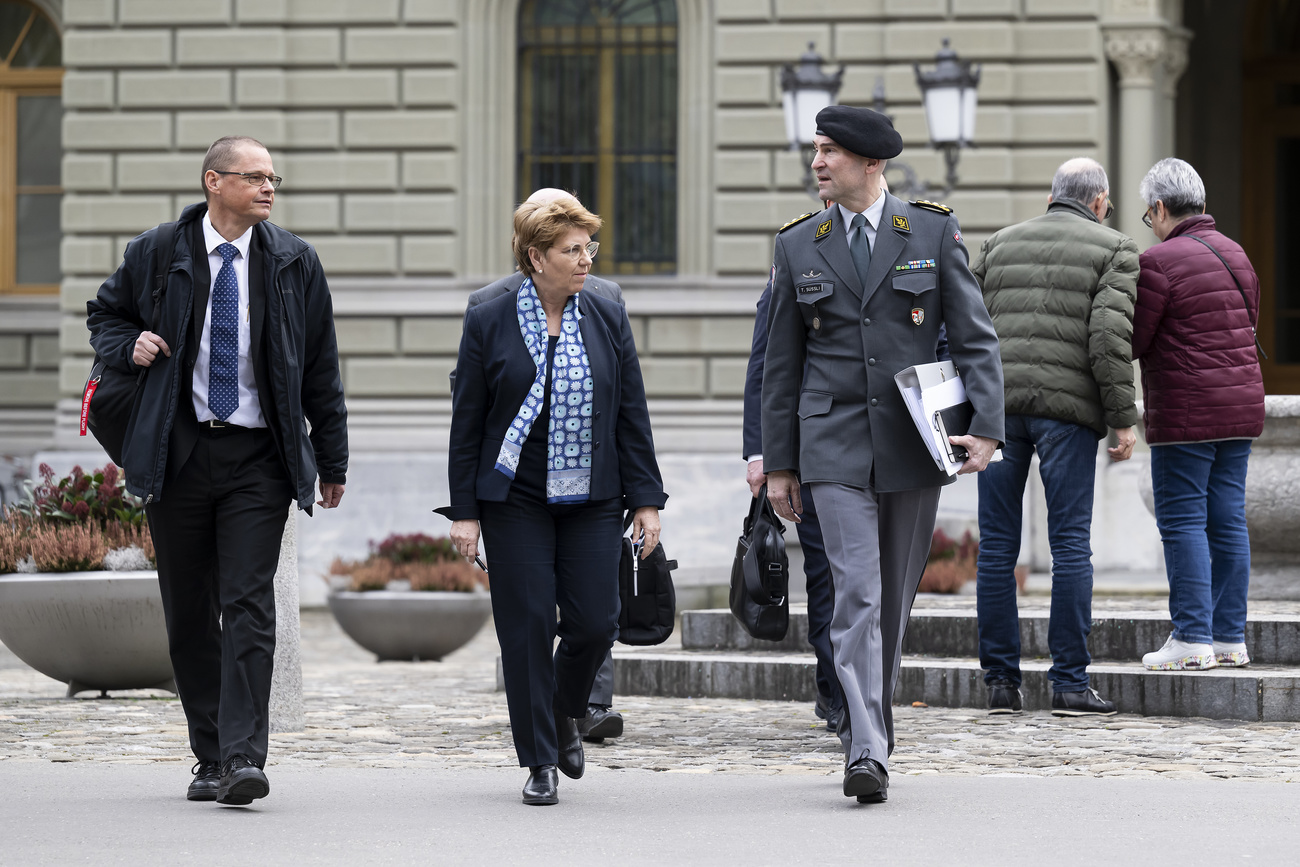
Swiss government requests billions for army

At a time when the armed forces are at the centre of discussions because of their financial situation, Defence Minister Viola Amherd asked on Wednesday for CHF4.9 billion ($5.5 billion) to equip the armed forces.
The spending ceiling for 2025 to 2028 is CHF25.8 billion.
The government is submitting five federal decrees to parliament. These are the target values for the orientation of the armed forces up to 2035, the procurement of armed forces equipment for the period 2024 to 2027 (CHF3.52 billion), the armaments programme 2024 (CHF490 million), the defence ministry building programme 2024 (CHF886 million) and the armed forces expenditure ceiling for the period 2025 to 2028 (CHF25.8 billion).
Since the end of the Cold War, European countries have reduced their armed forces and focused their activities on promoting peace. But the current armed conflicts have changed all that. Virtually all European countries are once again investing in their armed forces.
Parliament has already decided to increase the army budget to 1% of GDP by 2035, rather than by 2030 as originally planned. This will make it possible to fill the capability gaps that have built up over the past few decades more quickly and to strengthen defence capability.
“For the first time, parliament will be able to determine the long-term strategic direction and capabilities of the armed forces,” Amherd explained. In the past, it lacked an overall vision.
Ten strategic areas have been defined: leadership and networking, integrated intelligence and sensors, effect against air targets, effect against ground targets, effect in cyberspace and electromagnetic space, logistics, medical service, unprotected mobility on the ground, protected mobility on the ground and air mobility.
Acquisition of equipment over four years
The commitment credit for the acquisition of army equipment now covers four years. “This will give us greater planning certainty,” Amherd said at a press conference in Bern.
The total credit of CHF3.52 billion represents around CHF880 million per year, a similar amount to previous years. The largest item of expenditure (CHF2 billion) will be staff equipment and the replacement of materials. Some CHF800 million is earmarked for project studies, trials and preparations for procurement. Finally, CHF720 million is earmarked for training ammunition and ammunition management.
As part of the 2024 armament programme, the government is requesting commitment credits of CHF490 million. The land forces are to be equipped with a new missile system to combat armoured targets and key structures at long range (CHF210 million). “As the war in Ukraine has shown, this is the most important means of defence,” Amherd said.
Some CHF40 million has been earmarked for the purchase of semi-stationary sensors to improve the detection, identification, location and tracking of aircraft. Two other credits concern the defence ministry computing centres (CHF130 million) and cyber security (CHF40 million). Maintaining the value of the PC-7 training aircraft will cost CHF70 million.
Commitment credits for the 2024 building programme amount to CHF886 million. The construction costs for the Kastro II computing centre amount to CHF483 million. The route of a road at the Emmen air base is to be relocated at a cost of CHF14 million. Work will be carried out on the parade grounds at Frauenfeld (CHF93 million) and Bière (CHF46 million). The other projects are valued at CHF250 million.
Expenditure ceiling
The government is also submitting to parliament a spending ceiling for the years 2025 to 2028 amounting to CHF25.8 billion. This includes operating expenditure (CHF13.7 billion), armaments and capital expenditure (CHF11.8 billion) and a technical reserve of CHF312 million.
This ceiling is based on parliament’s decision on the 2024 budget, according to which armed forces expenditure will increase in real terms by 3% a year in 2025 and 2026, and by 5.1% in 2027.
Amherd also defended herself against criticism in recent weeks that the army had a “financial hole” and could not pay its bills. “This is false,” she said.
She pointed out that the army was not unable to pay, that no more orders had been placed than can be paid for, and that the amount described as a “financial hole” is nothing more than the difference between planning and available resources. A distinction must be made between planning and commitment appropriations on the one hand, and procurement contracts concluded with payment obligations on the other.
Translated from French by DeepL/ts
This news story has been written and carefully fact-checked by an external editorial team. At SWI swissinfo.ch we select the most relevant news for an international audience and use automatic translation tools such as DeepL to translate it into English. Providing you with automatically translated news gives us the time to write more in-depth articles.
If you want to know more about how we work, have a look here, and if you have feedback on this news story please write to english@swissinfo.ch.

In compliance with the JTI standards
More: SWI swissinfo.ch certified by the Journalism Trust Initiative































You can find an overview of ongoing debates with our journalists here . Please join us!
If you want to start a conversation about a topic raised in this article or want to report factual errors, email us at english@swissinfo.ch.